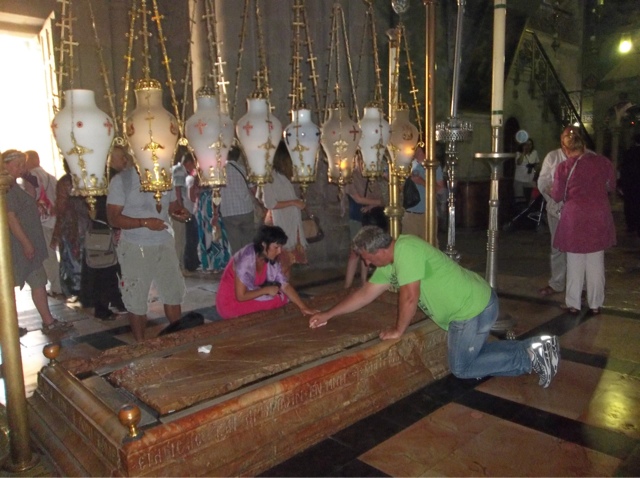And now a word about these gates. This city was a fortress: the gates were thick and high, with a double gate, slits for archers, and special holes through while boiling oil could be poured down on attackers. Today, the city gates stand open but it is internally divided into four quarters, listed from biggest to smallest: the Muslim Quarter, the Christian Quarter, the Armenian Quarter, and the Jewish Quarter. Yep, the Jewish Quarter is the smallest. And the Armenian Quarter is Christian but because they got here before all the other Christians (basically before Rome converted to Christianity), they get their own sector.
While Jerusalem is very much a living city, it has also been excavated to reveal the history beneath. The two Cardos (main streets in a Roman city) can be seen, excavated below main arteries of modern commerce. Archaeological sites such as the Herodian Quarter (within the Jewish Quarter) reveal the giant chambers of a high priest and indicate the social strife of millennia past. Mosaic floors, stucco walls, mikvahs (ritual baths), pottery shards, carvings of a menorah (the oldest known menorah representation in existence), Roman spearheads, and other finding help to educate us about the past buried beneath our feet. One can't help but wonder what other mysteries lie beneath the modern city.
Since Ronan, like Danny, seems to know everyone, we got to enter a yeshiva that had just finished hosting a bar mitzvah and... Beheld a spectacular view of the Western Wall and the mosque with the golden Dome.
When the Muslims conquered Jerusalem, they built a mosque over the ruins of the previous temples, in the spot where Abraham was ready to offer his son Isaac as sacrifice to God. As an Abrahamian religion, the Muslims also consider this site holy. Sadly, due to political divides between religions, Jewish pilgrims are not allowed even on the plaza around the mosque, and Christians are allowed on the plaza but not within the mosque, so neither of the other Abrahamian religions can worship at this holy site. For this reason, the Western Wall - the closest accessible point to the site of (attempted) sacrifice - has become the new holy site for the Jewish people. It is unknown why, in 1967 when the Jewish fighters recaptured Jerusalem, they did not tear down the mosque and begin the construction of a new temple. But that decision has meant that they do not have access to the temple and most content themselves with the wall.
The wall is one of four retaining walls built by Herod to create a flat plaza around the religious site and is a marvel of engineering. Only a small portion of the wall is visible above ground today, but underground tunnels beneath the Muslim Quarter show the length of the wall and the giant rocks quarried to build it. The longest one weighs over 250 tons and they are not sure exactly how it was moved there.
In comparison, the Christian sites are rather bland. The Church of the Holy Sepulcre is at the end of the Via Dolorosa, the path that Christ supposedly took while hauling his own cross to the site where he was crucified. Three of the stages of the cross took place inside the church: the crucifixion, the washing of the body, and the burial in a cave. Since these are about 50 steps from each other and all of these events are thought to have occurred outside of the city, the sites hold no real significance for those who prefer rationality to blind belief.
The stone upon which they say Christ's body was buried is apparently from the 1930s. Most of the pilgrims inside are of Eastern European origin and rub scarves and other belongings on the stone in the belief that holiness can be transported inside material things; they bring ashes from candles burned within the church home to their parishes.
The site is also part of a divisive power struggle between twelve sects, who block each other whenever possible. The rivalry is so bad that a trusted Muslim family holds the keys because the Christians can't trust each other. It's just sad. The interesting part about the Church of the Holy Sepulcre is that it was originally built by Helena, mother of Constantine, after he converted the Roman Empire to Christianity. It was one of the four churches she first built on holy sites. The original, sadly, was mostly destroyed. The current version is about half the size and was built by the Crusaders on the same site.
As we retraced our steps through the city, we wandered through the Muslim Quarter bazaar, which was like any other market: kitschy merchandise alongside fresh produce and gleaming sweets. There were quite a few pro-Palestinian shirts, often right next to an I <3 Israel display. It was quite strange, and also quite telling.
Two days in, Jerusalem continues to surprise, delight, and befuddle.
So many Spottings:
1. Cohen. This is derived for the name of the families of high priests/rabbis. Those who have this last name are descendants of those families.
2. Garbage tractors. Small ramps have been built into the ancient steps of the city for the purpose of garbage collection. Small tractors navigate the narrow streets, three times as tall as they are wide as they accumulate the city's waste. They often skim the tops of archways, but always miraculously pass through.
3. Fireworks in the Muslim Quarter. In the evening, these are set off by Muslims celebrating the end of fasting on the days of Ramadan. But this morning they were being set off to celebrate the end of school exams.
4. Hats. It's very strange to go into a building, take my hat off out of respect, and be scolded for not respectfully keeping it on. Covering your head is in here.








No comments:
Post a Comment